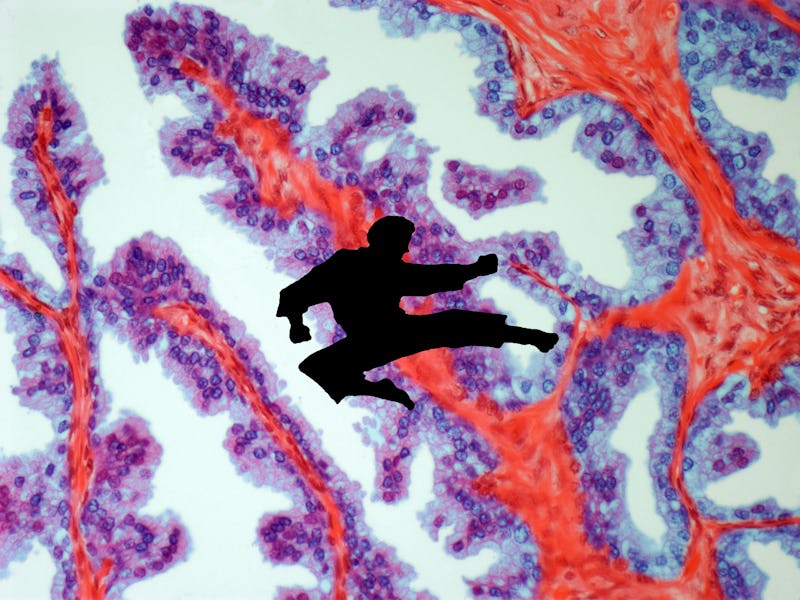One cheap, accessible lifestyle choice could prevent prostate cancer
Want to protect your prostate health? Break a sweat on a regular basis.

The prostate is a small, but mighty organ— the tiny gland, the size of a walnut, produces semen containing hundreds of millions of sperm per ejaculation, and is often referred to as the male “g-spot”.
For many men, it is also where they are likely to develop cancer — prostate cancer is the second most-common cancer to affect men — the disease affected over 1.2 million men worldwide in 2018 alone. But scientists don’t know this potentially fatal disease’s exact cause.
But just because they don’t know the cause, that doesn’t mean that it can’t be treated — or prevented. In fact, just taking up one good habit could help prevent prostate cancer from developing in the first place: move your body more.
That’s the upshot of a new study published this week in the International Journal of Epidemiology. It is the largest to date tying genetics, physical activity and prostate cancer together.
Prostate cancer is the second most-common cancer among men.
Sarah Lewis, the study’s lead author and researcher at Bristol University, hopes the findings will influence men’s lifestyle choices day to day.
“It suggests that there could be a larger effect of physical activity on prostate cancer than previously thought, so will hopefully encourage men to be more active,” Lewis said in a statement.
Exercise — intense or easy — helps
To drill down on the cancer’s causes, Lewis and the research team looked at 22 risk factors in over 140,000 men. About 57 percent of these men had prostate cancer. The team aimed to tease out how these risk factors, like obesity, iron levels, physical activity, and diet, affect the chances someone will get prostate cancer.
They found that being more active reduces the risk of prostate cancer. And the benefits of exercise didn’t require daily burpees or long-distance runs. Rather exercise of all intensities — whether it is pilates, a rock-climb, or a HIIT session — was associated with lower odds of prostate cancer.
The relationship between physical activity and prostate cancer is a dose response relationship, Lewis explains. So there’s no exact formula to fight prostate cancer, like three runs per week or a daily sweat session, for example. But following international exercise guidelines is a great place to start. The World Health Organization recommends two and a half hours of moderate activity, like gardening or walking, or 75 minutes of vigorous activity, like running or boxing, per week.
“The more active a man is, the lower their risk,” she says. “But this does not have to be at a vigorous level; it could simply be walking more.”
The power of “active genes”
The research also shines light on how genetics may predispose certain men to move more. In their analysis, people with two DNA variations associated with higher physical activity were 51 percent less likely to get prostate cancer than people who didn’t have these exercise-related genetic variations.
Someone’s genes are actually a fairly strong predictor of how active they are, Lewis says. Because it is accurate and relatively cheap, the researchers took this approach in the study. Instead of tracking how much study participants exercised every week or having men in the study take a survey to report activity, the research team used genetics as a measurement for physical activity.
The approach helps to cut down on confounders. People who exercise more may also be more likely to abstain from smoking or drinking, which is another risk factor, for example. The active genes aren’t associated with these other lifestyle factors, so the study results are cleaner, Lewis says.
Regardless of whether you have these genes or not, breaking a sweat is a good idea, she says. Preventing prostate cancer is just another reason to work out, in addition to the myriad of other benefits like a healthier heart, better mood, and sharper brain. So get moving— your sperm factory depends on it.
Abstract:
Background: Prostate cancer is the second most common male cancer worldwide, but there is substantial geographical variation, suggesting a potential role for modifiable risk factors in prostate carcinogenesis.
Methods: We identified previously reported prostate-cancer risk factors from the World Cancer Research Fund (WCRF)’s systematic appraisal of the global evidence (2018). We assessed whether each identified risk factor was causally associated with risk of overall (79 148 cases and 61 106 controls) or aggressive (15 167 cases and 58 308 controls) prostate cancer using Mendelian randomization (MR) based on genome-wide association-study summary statistics from the PRACTICAL and GAME-ON/ELLIPSE consortia. We assessed evidence for replication in UK Biobank (7844 prostate-cancer cases and 204 001 controls). Results: WCRF identified 57 potential risk factors, of which 22 could be instrumented for MR analyses using single nucleotide polymorphisms. For overall prostate cancer, we identified evidence compatible with causality for the following risk factors (odds ratio [OR] per standard deviation increase; 95% confidence interval): accelerometer-measured physical activity, OR1⁄40.49 (0.33–0.72; P1⁄40.0003); serum iron, OR1⁄40.92 (0.86–0.98; P1⁄40.007); body mass index (BMI), OR1⁄40.90 (0.84–0.97; P1⁄40.003); and monounsaturated fat, OR 1⁄4 1.11 (1.02–1.20; P 1⁄4 0.02). Findings in our replication analyses in UK Biobank were compatible with our main analyses (albeit with wide confidence intervals). In MR analysis, height was positively associated with aggressive-prostate-cancer risk: OR 1⁄4 1.07 (1.01–1.15; P 1⁄4 0.03).
Conclusions: The results for physical activity, serum iron, BMI, monounsaturated fat and 15 height are compatible with causality for prostate cancer. The results suggest that interven- tions aimed at increasing physical activity may reduce prostate-cancer risk, although interventions to change other risk factors may have negative consequences on other diseases.